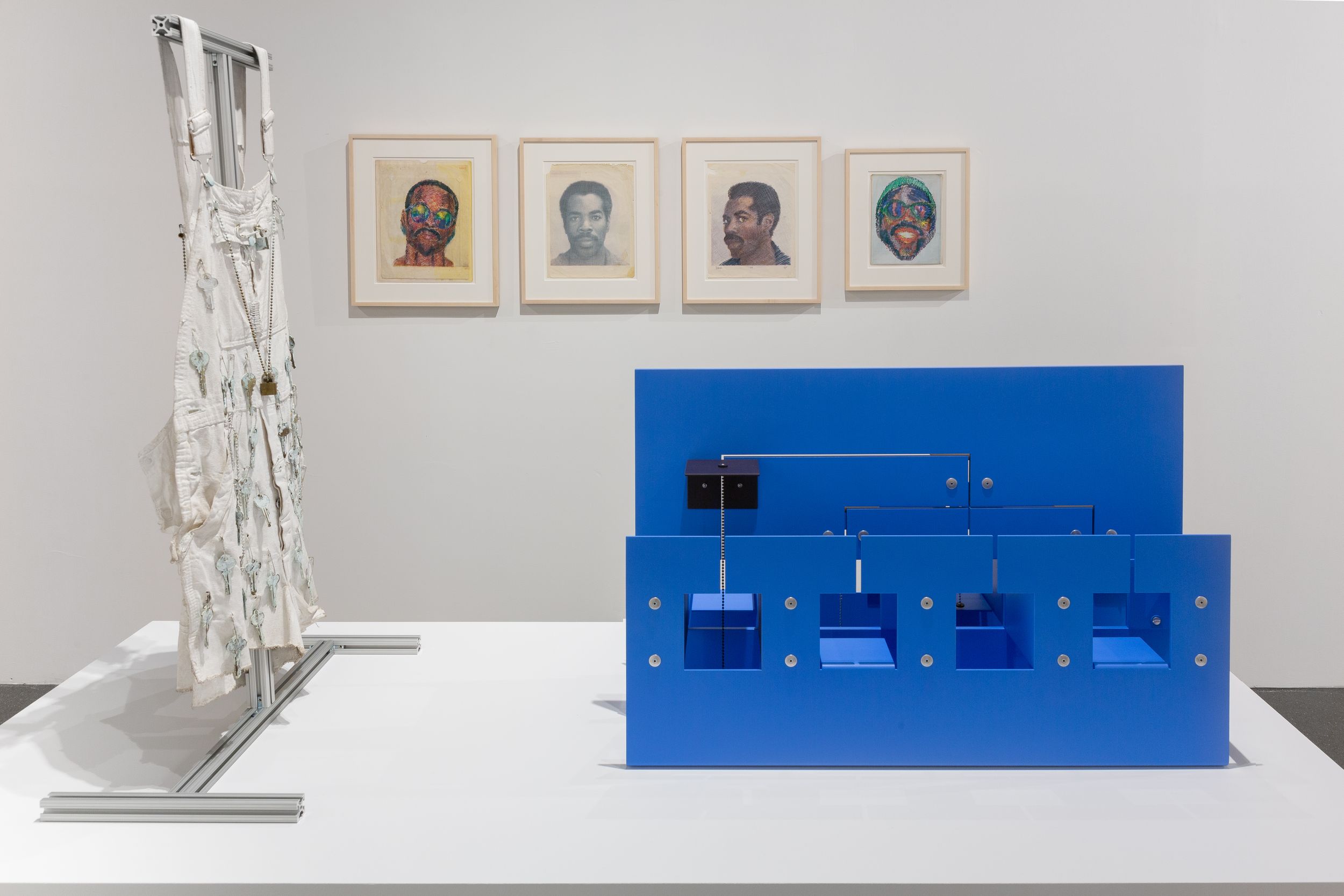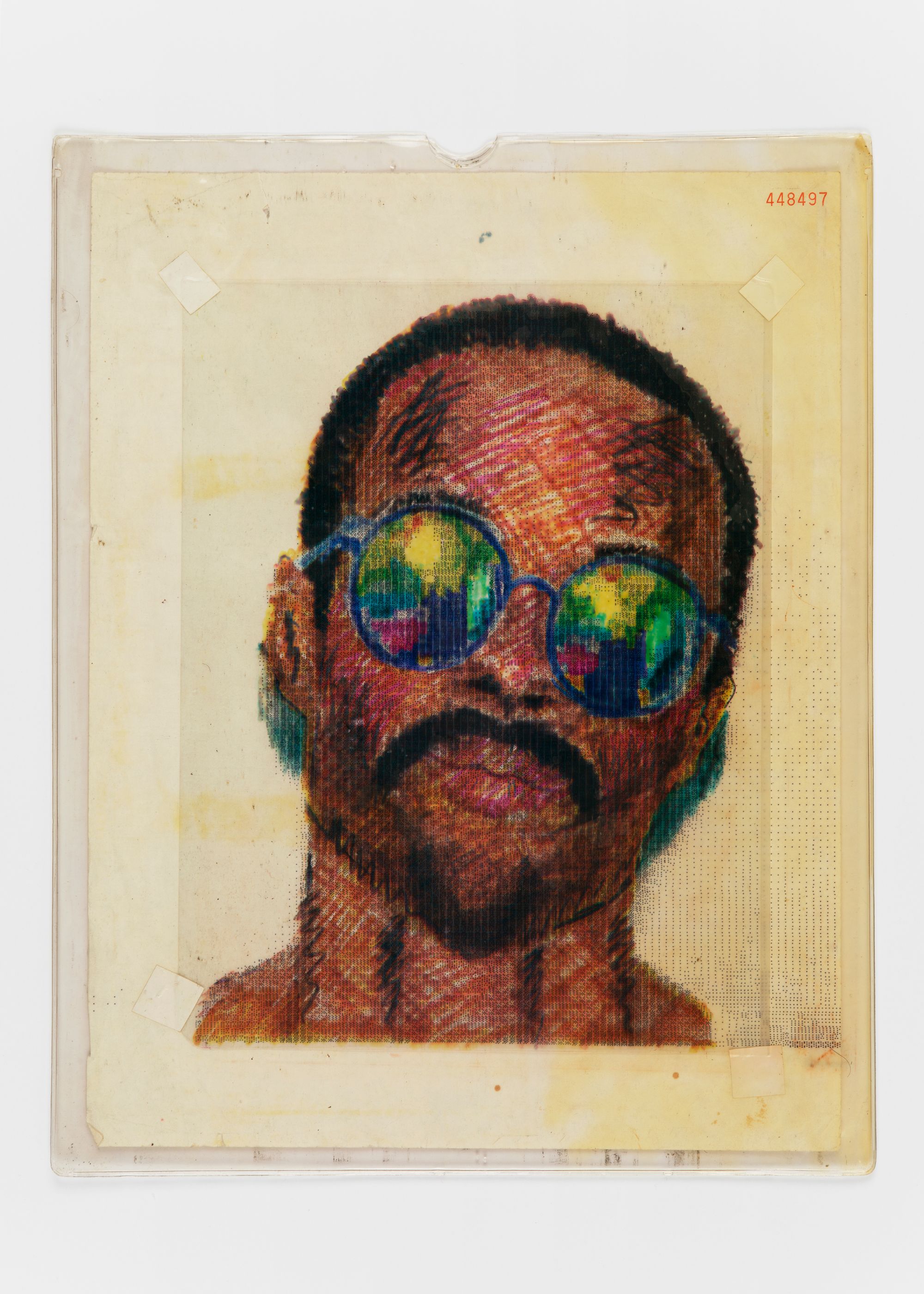Frederick Weston, Matt Paweski
Independent New York: Matt Paweski, Frederick Weston
Mar. 5–Mar. 8, 2020
For Gordon Robichaux’s inaugural participation in the Independent, we are pleased to present artwork by Matt Paweski and Frederick Weston. The artists’ standalone works—sculptures made of aluminum, an altered garment, paper collages, an array of photographic images—are presented in dialogue and include an armature conceived by Paweski to display a pair of Weston’s overalls. The presentation invites the viewer to explore both artists’ engagement with materiality, design, and production freed from the constraints of functionality, and the ways that material and social systems structure and inform our understanding of ourselves and the world around us.
Weston was trained as a fashion designer, and the works included here highlight his interdisciplinary activity across varied media and technologies: a series of dot-matrix portraits (of the artist and his friend, fashion designer Claude Payne) made in photo booths in Times Square in 1978–79; a pair of customized overalls—adorned with locks, safety pins, and paint—that the artist wore to Paradise Garage in the 1980s; and a 2013 Body Map collage populated by hundreds of images from Weston’s vast encyclopedic archive related to fashion, the body, advertising, race, AIDS, and queer subjects. Weston embraces and subverts the conventions of fashion design—conceptualizing mood boards and making paper patterns—to explore identity as a mutable construction. Weston looks to fashion—“the only true democracy that exists [since] everybody has to get up in the morning and put on an outfit that represents them”—as a pleasurable, expressive site of liberation where signifiers of race, gender, and class can mix and match like paper dolls.
Paweski’s metal sculptures, which he created specifically for the Independent, include: a large licorice-colored, circular wall work—held together with rubber o-rings, hard fiber-insulated washers, and stainless hair pin clips—and a vibrant, blue tabletop work punctuated by ball chains and rubber washers. Paweski uses industrial techniques and materials—industrial hardware; hand-assembled, riveted, and painted aluminum with a matte surface—for their “sensuousness,” he says, “their strength, their slick or dry, tactile, or sexy qualities.” He goes on: “The goal isn’t to try to solve an ergonomic problem, but to re-create the emotional response we have with that function.” Relieved of that expectation, the viewer is given over to the activity of reflexive observation, pleasure, and humor, engaged in a perceptual puzzle of positive and negative space, parts and whole, precision and sensuality. The idiosyncratic, colorful “knobs, buttons, chains, and handles,” cohere as vibrational compositions that suggest the logic of a machine freed from the necessity and constraints of functionality.
Matt Paweski was born in Detroit, Michigan, in 1980 and lives and works in Los Angeles. He received an MFA from Art Center College of Design, Pasadena, CA. Paweski is represented by Gordon Robichaux, New York; Herald St, London; and Park View / Paul Soto, Los Angeles. In 2020, his first monograph, MP.19, was published by Zolo Press.
Recent solo and two-person exhibitions include Tre sculture e un disegno, Octagon, Milan, IT; Look out, Switch—Switch, Couples, Fountain, Park View / Paul Soto, Los Angeles (2018); Gordon Robichaux, New York (2018, with Sanou Oumar); Lulu, Mexico City (2018, with Ella Kruglyanskaya); Herald St, London (2017 and 2014); Ratio 3, San Francisco (2016); and South Willard, Los Angeles (2015). Group exhibitions include City Prince/sses at The Palais De Tokyo, Paris; Condo, Park View / Paul Soto, hosted by Kurimanzutto, Mexico City; Rock, PHIL, Los Angeles; A Page From My Intimate Journal (Part I), Gordon Robichaux, New York; Condo, Park View / Paul Soto, hosted by Queer Thoughts, New York; and US Softcore, curated by Matt Paweski, South Willard, Los Angeles.
His work has been reviewed and featured in numerous publications: The New Yorker, The New York Times, Apartmento, Mousse Magazine, Contemporary Art Review Los Angeles, Contemporary Art Daily, Artforum, Los Angeles Review of Books, Artnet, Dwell Magazine, Art in America, Flash Art International, and New York Times T Magazine.
Frederick Weston was born in Memphis, Tennessee, in 1946, and raised in Detroit, Michigan, where he participated in the club scene before moving to New York City in the mid-1970s. He studied menswear design and marketing at the Fashion Institute of Technology. He is a self-taught interdisciplinary artist who works in varied media: collage, drawing, sculpture, photography, performance, and creative writing. Over the course of his time in New York, he has developed a vast, encyclopedic archive of images and ephemera related to fashion, the body, advertising, AIDS, race, and queer subjects. He currently lives and works in his apartment in New York City. Weston is represented by Gordon Robichaux, NY, where he presented his first New York solo exhibition in 2019. In 2020, he received the Foundation for Contemporary Arts’ Roy Lichtenstein Award and presented a site-specific installation at the gallery in the Ace Hotel in New York. A forthcoming book with an interview between Weston and Samuel R. Delany will be published by Visual AIDS in fall 2020.
He has exhibited his work widely in group exhibitions: Souls Grown Diaspora, apexart (curated by Sam Gordon); Heaven and Hell, Tom of Finland Foundation, Los Angeles; Tag: Proposals on Queer Play and the Ways Forward, Institute of Contemporary Art, University of Pennsylvania, PA (curated by Nayland Blake); This Must Be the Place, 55 Walker, NY (curated by O.O. & M.M. and Miles Huston); Inside, Out Here, La MaMa Galleria, NY (curated by Eric Booker); A Page from My Intimate Journal (Part I), Gordon Robichaux, NY; Art AIDS America, The Bronx Museum of the Arts; Found, Leslie Lohman Museum of Gay and Lesbian Art, NY (curated by Avram Finkelstein); CUT HERE (with Matt Keegan and Siobhan Liddell), Gordon Robichaux, NY; Queer Artist Fellowship: Alternate Routes, Leslie Lohman Project Space, NY (curated by Osman Can Yerebakan); and Persons of Interest, Bureau of General Services, the Lesbian, Gay, Bisexual, and Transgender Community Center, NY (curated by Sam Gordon).
He has participated in numerous panels and presented his creative writing and poetry for Visual AIDS; Queer Artists of Color in New York during the AIDS Epidemic, College Art Association of America, 2019 Annual Conference, NY; Visual Arts and the AIDS Epidemic: Smithsonian Archives of American Art Symposium, Whitney Museum of American Art, NY; Fag, Stag, or Drag? John Neff and Frederick Weston in Conversation, Artists Space, NY; Three Readings: Wayne Koestenbaum, Darinka Novitovic, and Frederick Weston, Gordon Robichaux, NY. In 2017, an oral history with Weston, conducted by Ted Kerr, was published by the Smithsonian Archives of American Art for Visual Arts and the AIDS Epidemic: An Oral History Project.
Weston’s work has been lauded by Holland Cotter in The New York Times on two occasions, by Jerry Saltz in New York magazine, and in numerous publications including Artforum, The Brooklyn Rail, and Hauser & Wirth’s Ursula magazine.




Matt Paweski
LATTICE (FM), 2020
Aluminum, aluminum hardware, aluminum rivets, rubber, vinyl paint, 20 x 32 x 12 inches

Frederick Weston
Make Some Noise (Paradise Garage), circa 1987
Altered garment with acrylic and found objects, 32 x 18 x 12 inches

Frederick Weston
Claude Payne, 1979
Marker, tape, Xerox, paper, plastic, 14 7/8 x 11 3/4 inches

Frederick Weston
Self Portrait, 1979
Dot matrix print, tape, 14 1/8 x 10 3/4 inches

Frederick Weston
Self Portrait, 1979
Colored pencil on dot matrix print, 14 1/8 x 10 3/4 inches

Frederick Weston
Freddy in Green (Paradise Garage), 1979
Color photocopy, plastic, 11 x 8 7/8 inches